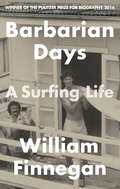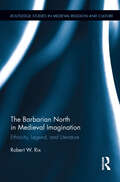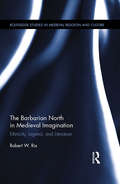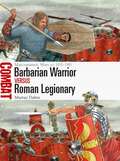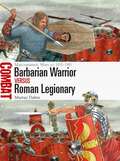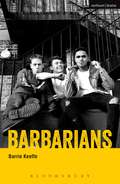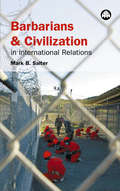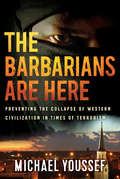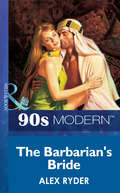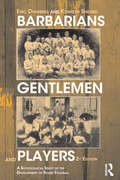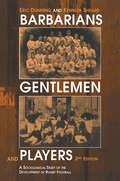- Table View
- List View
Barbarian Days: A Surfing Life
by William FinneganWinner of the Pulitzer Price and William Hill Sports Book of the Year: Barbarian Days is a deeply rendered self-portrait of a lifelong surfer looking for transcendence 'that recalls early James Salter' (Geoff Dyer, Observer)Surfing only looks like a sport. To devotees, it is something else entirely: a beautiful addiction, a mental and physical study, a passionate way of life.New Yorker writer William Finnegan first started surfing as a young boy in California and Hawaii. Barbarian Days is his immersive memoir of a life spent travelling the world chasing waves through the South Pacific, Australia, Asia, Africa and beyond. Finnegan describes the edgy yet enduring brotherhood forged among the swell of the surf; and recalling his own apprenticeship to the world's most famous and challenging waves, he considers the intense relationship formed between man, board and water.Barbarian Days is an old-school adventure story, a social history, an extraordinary exploration of one man's gradual mastering of an exacting and little-understood art. It is a memoir of dangerous obsession and enchantment. 'Reading this guy on the subject of waves and water is like reading Hemingway on bullfighting; William Burroughs on controlled substances; Updike on adultery. . . . a coming-of-age story, seen through the gloss resin coat of a surfboard' Sports Illustrated
Barbarian Memory: The Legacy Of Early Medieval History In Early Modern Literature
by N. BirnsAn investigation of the use of Late Antique European history by late medieval and Renaissance writers such as Chaucer, Shakespeare, Davenant, Trissino, and Corneille. The liminality of the late antique period and the issues of ethnicity and religion it raises makes it very different from that of the classical world in analogous writers.
The Barbarian North in Medieval Imagination: Ethnicity, Legend, and Literature (Routledge Studies in Medieval Religion and Culture)
by Robert RixThis book examines the sustained interest in legends of the pagan and peripheral North, tracing and analyzing the use of an ‘out-of-Scandinavia’ legend (Scandinavia as an ancestral homeland) in a wide range of medieval texts from all over Europe, with a focus on the Anglo-Saxon tradition. The pagan North was an imaginative region, which attracted a number of conflicting interpretations. To Christian Europe, the pagan North was an abject Other, but it also symbolized a place from which ancestral strength and energy derived. Rix maps how these discourses informed ‘national’ legends of ancestral origins, showing how an ‘out-of-Scandinavia’ legend can be found in works by several familiar writers including Jordanes, Bede, ‘Fredegar’, Paul the Deacon, Freculph, and Æthelweard. The book investigates how legends of northern warriors were first created in classical texts and since re-calibrated to fit different medieval understandings of identity and ethnicity. Among other things, the ‘out-of-Scandinavia’ tale was exploited to promote a legacy of ‘barbarian’ vigor that could withstand the negative cultural effects of Roman civilization. This volume employs a variety of perspectives cutting across the disciplines of poetry, history, rhetoric, linguistics, and archaeology. After years of intense critical interest in medieval attitudes towards the classical world, Africa, and the East, this first book-length study of ‘the North’ will inspire new debates and repositionings in medieval studies.
The Barbarian North in Medieval Imagination: Ethnicity, Legend, and Literature (Routledge Studies in Medieval Religion and Culture)
by Robert RixThis book examines the sustained interest in legends of the pagan and peripheral North, tracing and analyzing the use of an ‘out-of-Scandinavia’ legend (Scandinavia as an ancestral homeland) in a wide range of medieval texts from all over Europe, with a focus on the Anglo-Saxon tradition. The pagan North was an imaginative region, which attracted a number of conflicting interpretations. To Christian Europe, the pagan North was an abject Other, but it also symbolized a place from which ancestral strength and energy derived. Rix maps how these discourses informed ‘national’ legends of ancestral origins, showing how an ‘out-of-Scandinavia’ legend can be found in works by several familiar writers including Jordanes, Bede, ‘Fredegar’, Paul the Deacon, Freculph, and Æthelweard. The book investigates how legends of northern warriors were first created in classical texts and since re-calibrated to fit different medieval understandings of identity and ethnicity. Among other things, the ‘out-of-Scandinavia’ tale was exploited to promote a legacy of ‘barbarian’ vigor that could withstand the negative cultural effects of Roman civilization. This volume employs a variety of perspectives cutting across the disciplines of poetry, history, rhetoric, linguistics, and archaeology. After years of intense critical interest in medieval attitudes towards the classical world, Africa, and the East, this first book-length study of ‘the North’ will inspire new debates and repositionings in medieval studies.
The Barbarian Nurseries
by Héctor TobarThe morning after the fight, Maureen Torres-Thompson picked up the baby and left. She ran her beautiful home in a gated community just outside LA like the disciplined mid-level corporate executive she had once been. She often thought that the only thing she could say with certainty she wanted, was to bring goodness and beauty to the life of her family. And now Scott was telling her they were broke. If they could no longer afford a gardener, it had seemed sensible to replace the high-maintenance la petit rainforest with an architecturally interesting cactus garden. Inevitably that had required some initial outlay. They had a fight. Scott left too. When Scott and Maureen finally return home, the children have gone. Shocked at their own behaviour and terrified by what people will think of them they do what any right-minded middle-class parents would do. They lie. And accuse the maid. As a national media circus explodes over the 'abduction', carefully constructed lives begin to fall apart. In a city divided between a wealthy privileged class and a rising immigrant population every organization from the broken criminal justice system to the social services has a reason for wanting the story to end a certain way. A compelling portrait of our time, THE BARBARIAN NURSERIES questions how far we'll go to protect our ambitions, our liberty and our family.
The Barbarian of World's End
by Lin CarterGanelon Silvermane, the genetically designed superhero of the Earth's fabulous final age, has offered himself as hostage to the worst band of barbarians to roam the plains. As a captive of the Horde, Ganelon rises to greater heights of heroism than ever before . . . and begins to assume the full power of his mighty being!
The Barbarian Temperament: Towards a Postmodern Critical Theory
by Stejpan MestrovicThis scintillating book by one of the most interesting young sociologists currently working in the USA is a provocative and timely contribution to the debate on civilization, modernity and postmodernity. The author argues that modernity never jettisoned barbarism. Instead barbarism was repackaged in modern and postmodern traditions and cultures.
The Barbarian Temperament: Towards a Postmodern Critical Theory
by Stejpan MestrovicThis scintillating book by one of the most interesting young sociologists currently working in the USA is a provocative and timely contribution to the debate on civilization, modernity and postmodernity. The author argues that modernity never jettisoned barbarism. Instead barbarism was repackaged in modern and postmodern traditions and cultures.
Barbarian Warrior vs Roman Legionary: Marcomannic Wars AD 165–180 (Combat #76)
by Dr Murray DahmThis engrossing book pits the legionaries of Imperial Rome against their Germanic and Sarmatian opponents in the 2nd century AD.Shortly after Marcus Aurelius came to power in AD 161, the Roman Empire was racked by a series of military crises. While unrest in Britain and a new war with Parthia were swiftly dealt with, the invasion of Roman territory by the Chatti and Chauci peoples heralded a resurgent threat from the empire's European neighbours. Soon the Marcomanni and the Quadi, as well as the Dacians and the Sarmatian Iazyges, would attack the Romans in a series of savage conflicts that continued until AD 175 and would see the first invasion of Roman Italy since the beginning of the 1st century BC.In this book, the two sides' objectives, weapons and equipment and fighting styles are assessed and compared in the context of three featured battles: Carnuntum (170), where a Roman legion was vanquished and Italy invaded; the 'Battle on the Ice' (172), where the Romans fought their lighter-armed Iazyges opponents on the frozen Danube; and the so-called 'Miracle of the Rain' (174), during which a trapped Roman force facing annihilation was able to defeat numerically superior Germanic forces. Photographs, specially commissioned artwork plates and mapping complement the authoritative text in this engrossing study of Imperial Rome at war.
Barbarian Warrior vs Roman Legionary: Marcomannic Wars AD 165–180 (Combat #76)
by Dr Murray DahmThis engrossing book pits the legionaries of Imperial Rome against their Germanic and Sarmatian opponents in the 2nd century AD.Shortly after Marcus Aurelius came to power in AD 161, the Roman Empire was racked by a series of military crises. While unrest in Britain and a new war with Parthia were swiftly dealt with, the invasion of Roman territory by the Chatti and Chauci peoples heralded a resurgent threat from the empire's European neighbours. Soon the Marcomanni and the Quadi, as well as the Dacians and the Sarmatian Iazyges, would attack the Romans in a series of savage conflicts that continued until AD 175 and would see the first invasion of Roman Italy since the beginning of the 1st century BC.In this book, the two sides' objectives, weapons and equipment and fighting styles are assessed and compared in the context of three featured battles: Carnuntum (170), where a Roman legion was vanquished and Italy invaded; the 'Battle on the Ice' (172), where the Romans fought their lighter-armed Iazyges opponents on the frozen Danube; and the so-called 'Miracle of the Rain' (174), during which a trapped Roman force facing annihilation was able to defeat numerically superior Germanic forces. Photographs, specially commissioned artwork plates and mapping complement the authoritative text in this engrossing study of Imperial Rome at war.
Barbarians
by Tim Glencross'A dazzling debut' The Times It is 2008, late capitalism is in crisis, and the great and the good are gathered at an Islington house party. Hosting proceedings are waspish Sherard Howe, scion of a publishing dynasty and owner of a left-wing magazine, and his wife, Daphne Depree, whose feminist work The Third Sex is seen - to her increasing discomfort - as an intellectual cornerstone of the Blair era. The guests include cabinet ministers, celebrated artists and peers of the realm; but somehow it's doubtful that any number of grandees would overshadow Afua, the Howes' beautiful and supremely ambitious adopted daughter, already a rising star of the Labour Party.Into this world arrives twenty-four-year-old Elizabeth "Buzzy" Price, an aspiring poet only too aware of her suburban background. Moral support is at hand from shy but devoted Henry, the Howes' biological son - though perhaps Buzzy is most grateful for her friend's connection to her own unrequited love, Afua's boyfriend, the worldly Marcel.As the years pass and a coalition government takes office, Buzzy's fortunes rise and the elder Howes' lives threaten to unravel. But do the civilising possibilities of art involve enlarging Buzzy's romantic ambitions, or revealing their moral complacency? And could meek and gentle Henry, having angered his family by going to work for the political enemy, turn out to be steelier than anyone thought - as steely, even, as his formidable adopted sister?Barbarians is a debut of extraordinary scope and confidence; a fresh, contemporary novel about love, art and politics, told with a 19th century sensibility.
Barbarians (Modern Plays)
by Barrie KeeffeIt's 1977. Youth unemployment is at an all-time high and the pound is at an all-time low. Paul, Jan and Louis are bored, broke and demoralized by the hand that they've been dealt. How will these young lads fair with the odds stacked against them? How will they cope?Cut off from society with no-where to turn, the play resonates with a modern audience who will no doubt recognize the disaffected youth of 1970s Britain. Barrie Keeffe's tragically dark play crackles with tension throughout, building to a twisted and dramatic end.This programme text edition was published to coincide with the revival of the play by Tooting Arts Club on 3rd October 2015, staged at the former Central St Martins School of Art on the Charing Cross Road, London.
Barbarians: One: Gimme Shelter (gem, Gotcha, Getaway): Barbarians (killing Time, Abide With Me, In The City) (Modern Plays)
by Barrie KeeffeIt's 1977. Youth unemployment is at an all-time high and the pound is at an all-time low. Paul, Jan and Louis are bored, broke and demoralized by the hand that they've been dealt. How will these young lads fair with the odds stacked against them? How will they cope?Cut off from society with no-where to turn, the play resonates with a modern audience who will no doubt recognize the disaffected youth of 1970s Britain. Barrie Keeffe's tragically dark play crackles with tension throughout, building to a twisted and dramatic end.This programme text edition was published to coincide with the revival of the play by Tooting Arts Club on 3rd October 2015, staged at the former Central St Martins School of Art on the Charing Cross Road, London.
Barbarians: Rebellion and Resistance to the Roman Empire
by Dr Stephen P. Kershaw'And now what will become of us without barbarians?Those people were a sort of solution.' 'Waiting for the Barbarians' C. P. CavafyHistory is written by the victors, and Rome had some very eloquent historians. Those the Romans regarded as barbarians left few records of their own, but they had a tremendous impact on the Roman imagination. Resisting from outside Rome's borders or rebelling from within, they emerge vividly in Rome's historical tradition, and left a significant footprint in archaeology.Rome's history, as written by the Romans, follows a remarkable trajectory from its origins as a tiny village of refugees from a conflict zone to a dominant superpower, before being transformed into the medieval and Byzantine worlds. But throughout this history, Rome faced significant resistance and rebellion from peoples whom it regarded as barbarians. Gibbon saw the Roman Empire as one of the highest points of human achievement destroyed by barbarian invaders: Ostrogoths, Visigoths, Goths, Vandals, Huns, Picts and Scots. To others, as Rome was ravaged, new life was infused into an expiring Italy. Gibbon's 'decline and fall' has been reappraised as transformation, through religious and cultural revolution. Based both on ancient historical writings and modern archaeological research, this new history takes a fresh look at the Roman Empire, through the personalities and lives of key opponents of Rome's rise, dominance and fall - or transformation. These include: Brennus, the Gaul who sacked Rome; the Plebs, those barbarous insiders and internal resistors; Hannibal; Viriathus, the Iberian shepherd and skilled guerilla; Jugurtha and the struggle to free Africa; the Germanic threat from the Cimbri and the Teutones; Spartacus, the gladiator; Vercingetorix and rebellion in Gaul; Cleopatra; Boudicca, the Queen of the Iceni and the scourge of Rome; the Great Jewish Revolt; Alaric the Goth and the Sack of Rome; Attila the Hun, 'Born to Shake the Nations'; and the Vandals and the fall of Rome.
Barbarians and Brothers: Anglo-American Warfare, 1500-1865
by Wayne E. LeeThe most important conflicts in the founding of the English colonies and the American republic were fought against enemies either totally outside of their society or within it: barbarians or brothers. In this work, Wayne E. Lee presents a searching exploration of early modern English and American warfare, looking at the sixteenth-century wars in Ireland, the English Civil War, the colonial Anglo-Indian wars, the American Revolution, and the American Civil War. Crucial to the level of violence in each of these conflicts was the perception of the enemy as either a brother (a fellow countryman) or a barbarian. But Lee goes beyond issues of ethnicity and race to explore how culture, strategy, and logistics also determined the nature of the fighting. Each conflict contributed to the development of American attitudes toward war. The brutal nature of English warfare in Ireland helped shape the military methods the English employed in North America, just as the legacy of the English Civil War cautioned American colonists about the need to restrain soldiers' behavior. Nonetheless, Anglo-Americans waged war against Indians with terrifying violence, in part because Native Americans' system of restraints on warfare diverged from European traditions. The Americans then struggled during the Revolution to reconcile these two different trends of restraint and violence when fighting various enemies. Through compelling campaign narratives, Lee explores the lives and fears of soldiers, as well as the strategies of their commanders, while showing how their collective choices determined the nature of wartime violence. In the end, the repeated experience of wars with barbarians or brothers created an American culture of war that demanded absolute solutions: enemies were either to be incorporated or rejected. And that determination played a major role in defining the violence used against them.
Barbarians and Brothers: Anglo-American Warfare, 1500-1865
by Wayne E. LeeThe most important conflicts in the founding of the English colonies and the American republic were fought against enemies either totally outside of their society or within it: barbarians or brothers. In this work, Wayne E. Lee presents a searching exploration of early modern English and American warfare, looking at the sixteenth-century wars in Ireland, the English Civil War, the colonial Anglo-Indian wars, the American Revolution, and the American Civil War. Crucial to the level of violence in each of these conflicts was the perception of the enemy as either a brother (a fellow countryman) or a barbarian. But Lee goes beyond issues of ethnicity and race to explore how culture, strategy, and logistics also determined the nature of the fighting. Each conflict contributed to the development of American attitudes toward war. The brutal nature of English warfare in Ireland helped shape the military methods the English employed in North America, just as the legacy of the English Civil War cautioned American colonists about the need to restrain soldiers' behavior. Nonetheless, Anglo-Americans waged war against Indians with terrifying violence, in part because Native Americans' system of restraints on warfare diverged from European traditions. The Americans then struggled during the Revolution to reconcile these two different trends of restraint and violence when fighting various enemies. Through compelling campaign narratives, Lee explores the lives and fears of soldiers, as well as the strategies of their commanders, while showing how their collective choices determined the nature of wartime violence. In the end, the repeated experience of wars with barbarians or brothers created an American culture of war that demanded absolute solutions: enemies were either to be incorporated or rejected. And that determination played a major role in defining the violence used against them.
Barbarians and Civilization in International Relations
by Mark B. SalterThe terrorist attacks in New York and Washington have led to popular conceptions of Muslims as terrorists. Some commentators have harked back to the 'Clash of Civilizations' argument outlined by Samuel Huntington which argued that, after the collapse of the Cold War, culture would become the main axis of conflict for civilisational alliances. *BR**BR*Mark Salter takes issue with Huntington's theory and explains how the terms of his argument are part of an imperialist discourse that casts other civilisations as essentially barbarian.*BR**BR*Although many commentators have engaged with Huntington's claims, few have pursued the political implications of his argument. Barbarians and Civilisation offers a decisive exploration of the colonial rhetoric inherent in current political discourse. Charting the usefulness of concepts of culture and identity for understanding world politics, Salter brilliantly illustrates the benefits and the limitations of the civilised/barbarian dichotomy in international relations.
Barbarians and Romans, A.D. 418-584: The Techniques of Accommodation
by Walter A. GoffartDespite intermittent turbulence and destruction, much of the Roman West came under barbarian control in an orderly fashion. Goths, Burgundians, and other aliens were accommodated within the provinces without disrupting the settled population or overturning the patterns of landownership. Walter Goffart examines these arrangements and shows that they were based on the procedures of Roman taxation, rather than on those of military billeting (the so-called hospitalitas system), as has long been thought. Resident proprietors could be left in undisturbed possession of their lands because the proceeds of taxation,rather than land itself, were awarded to the barbarian troops and their leaders.
Barbarians and Romans, A.D. 418-584: The Techniques of Accommodation
by Walter A. GoffartDespite intermittent turbulence and destruction, much of the Roman West came under barbarian control in an orderly fashion. Goths, Burgundians, and other aliens were accommodated within the provinces without disrupting the settled population or overturning the patterns of landownership. Walter Goffart examines these arrangements and shows that they were based on the procedures of Roman taxation, rather than on those of military billeting (the so-called hospitalitas system), as has long been thought. Resident proprietors could be left in undisturbed possession of their lands because the proceeds of taxation,rather than land itself, were awarded to the barbarian troops and their leaders.
The Barbarians Are Here: Preventing the Collapse of Western Civilization in Times of Terrorism
by Michael YoussefFor decades, Americans were vaguely aware that Islamist barbarians were in the deserts of the Middle East and in the mountains of Afghanistan and Pakistan, executing "infidels" and raiding villages with unrecognizable names. But the Muslim world seemed far away, remote, and irrelevant to our daily lives. Then came the terrorist attacks of 9/11, followed by attacks at Fort Hood, the Boston Marathon, San Bernardino, and more. Now terrorists seem to be emerging everywhere, unleashing senseless death and destruction on our nation. They are here, and their goal is nothing less than global conquest. Motivated by ancient prophecies, they are flooding into Western countries determined to conquer our countries and establish a global Muslim caliphate. In The Barbarians Are Here, Dr. Michael Youssef provides clear insight into the motives and mission of the Islamic extremists. He offers practical steps we can take right now to begin a New Reformation that will restore the hope of Western civilization. It's not too late. We are not doomed to destruction, even though the barbarians are already here. But we haven't a moment to lose. "Let this book shape how you think, pray, and take the Gospel to the ends of the earth." -- R. Albert Mohler, Jr., President of The Southern Baptist Theological Seminary "I want every American, every citizen, and every member of my family to read this book. It is foolhardy not to." -- Pat Boone, Entertainer, Pat Boone Enterprises
Barbarians at the Wall: The First Nomadic Empire and the Making of China
by John Man'Man does for the reader that most difficult of tasks: he conjures up an ancient people in an alien landscape in such a way as to make them live.' Guardian____________________The people of the first nomadic empire left no written records, but from 200 BC they dominated the heart of Asia for 400 years. They changed the world. The Mongols, today’s descendants of Genghis Khan, see them as ancestors. Their rise cemented Chinese unity and inspired the first Great Wall. Their heirs under Attila the Hun helped destroy the Roman Empire. We don’t know what language they spoke, but they became known as Xiongnu, or Hunnu, a term passed down the centuries and across Eurasia, enduring today in shortened form as ‘Hun’. Outside Asia precious little is known of their rich history, but new evidence reframes our understanding of the indelible mark they left on a vast region stretching from Europe and sweeping right across Central Asia deep into China. Based on meticulous research and new archaeological evidence, Barbarians at the Wall traces their epic story, and shows how the nomadic cultures of the steppes gave birth to a ‘barbarian empire’ with the wealth and power to threaten the civilised order of the ancient world.
The Barbarian's Bride (Mills And Boon Vintage 90s Modern Ser.)
by Alex RyderThe bartered bride! To Kassim Riffik, Janene was worth fifty thousand pounds of cool hard cash. That was the exact amount her wayward boyfriend owed him and Kassim always collected on his debts. Being abducted by the sexiest man on two legs, even if he was a Barbarian, was clearly no joke for Janene.
Barbarians, Gentlemen and Players: A Sociological Study of the Development of Rugby Football (Sport in the Global Society)
by Kenneth Sheard Eric DunningFirst published in 1979, this classic study of the development of rugby from folk game to its modern Union and League forms has become a seminal text in sport history. In a new epilogue the authors provide sociological analysis of the major developments in international ruby that have taken place since 1979, with particular attention to the professionalism that was predicted in the first edition of this text. Sports lovers, rugby fans and students of the history and sociology of sport will find it invaluable.Rugby football is descended from winter 'folk games' which were a deeply rooted tradition in pre-industrial Britain. This was the first book to study the development of Rugby from this folk tradition to the game in its modern forms. The folk forms of football were extremely violent and serious injuries - even death - were a common feature. The game was refined in the public schools who played a crucial role in formulating the rules which required footballers to exercise greater self-control. With the spread of rugby into the wider society, the Rugby Football Union was founded but class tensions led to the split between Rugby Union and Rugby League. The authors examine the changes that led to the professionalisation of Rugby Union as well as the alleged resurgence of violence in the modern game.
Barbarians, Gentlemen and Players: A Sociological Study of the Development of Rugby Football (Sport in the Global Society)
by Kenneth Sheard Eric DunningFirst published in 1979, this classic study of the development of rugby from folk game to its modern Union and League forms has become a seminal text in sport history. In a new epilogue the authors provide sociological analysis of the major developments in international ruby that have taken place since 1979, with particular attention to the professionalism that was predicted in the first edition of this text. Sports lovers, rugby fans and students of the history and sociology of sport will find it invaluable.Rugby football is descended from winter 'folk games' which were a deeply rooted tradition in pre-industrial Britain. This was the first book to study the development of Rugby from this folk tradition to the game in its modern forms. The folk forms of football were extremely violent and serious injuries - even death - were a common feature. The game was refined in the public schools who played a crucial role in formulating the rules which required footballers to exercise greater self-control. With the spread of rugby into the wider society, the Rugby Football Union was founded but class tensions led to the split between Rugby Union and Rugby League. The authors examine the changes that led to the professionalisation of Rugby Union as well as the alleged resurgence of violence in the modern game.
